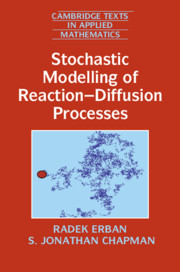Book contents
- Frontmatter
- Contents
- Preface
- 1 Stochastic Simulation of Chemical Reactions
- 2 Deterministic versus Stochastic Modelling
- 3 Stochastic Differential Equations
- 4 Diffusion
- 5 Efficient Stochastic Modelling of Chemical Reactions
- 6 Stochastic Reaction–Diffusion Models
- 7 SSAs for Reaction–Diffusion–Advection Processes
- 8 Microscopic Models of Brownian Motion
- 9 Multiscale and Multi-Resolution Methods
- Appendix
- References
- Index
3 - Stochastic Differential Equations
Published online by Cambridge University Press: 04 November 2019
- Frontmatter
- Contents
- Preface
- 1 Stochastic Simulation of Chemical Reactions
- 2 Deterministic versus Stochastic Modelling
- 3 Stochastic Differential Equations
- 4 Diffusion
- 5 Efficient Stochastic Modelling of Chemical Reactions
- 6 Stochastic Reaction–Diffusion Models
- 7 SSAs for Reaction–Diffusion–Advection Processes
- 8 Microscopic Models of Brownian Motion
- 9 Multiscale and Multi-Resolution Methods
- Appendix
- References
- Index
Summary
This chapter introduces stochastic differential equations (SDEs) from the computational point of view, starting with several examples to illustrate the computational definition of the SDE that is used throughout the book. The Fokker–Planck and Kolmogorov backward equations are then derived and their consequences presented. They are used to compute the mean transition time between favourable states of SDEs. The SDE formalism is then applied to a chemical system by deriving the chemical Fokker–Planck equation and the corresponding chemical Langevin equation. They are used to further analyse the chemical systems from Chapter 2, including the system with multiple favourable states and the self-induced stochastic resonance.
Keywords
- Type
- Chapter
- Information
- Stochastic Modelling of Reaction–Diffusion Processes , pp. 59 - 94Publisher: Cambridge University PressPrint publication year: 2020

